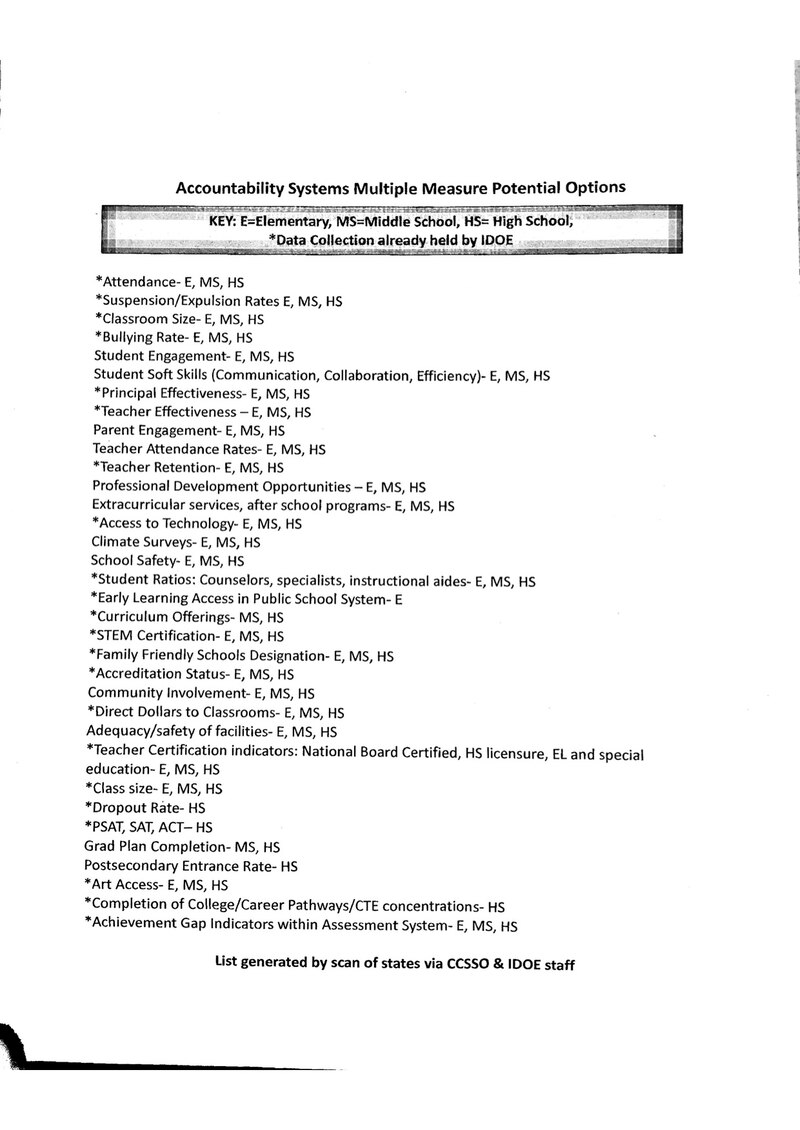As Indiana — and the rest of the country — moves away from measuring schools based solely on student test scores, there are a lot of options on the table.
Thirty-four options, to be exact.
That’s how many ideas Indiana officials came up with when they surveyed other states to find out how they’re planning to go beyond test scores to assess schools, which the new federal education law requires.
The list ranges from including attendance to class size to student surveys. Some of the ideas could go into practice fairly quickly, while others would require new data to be collected. Some ideas are already in play in other states, but others might not meet federal rules.
Ultimately, the state will have to choose one to use in its new A-F letter grade system, but for now, all are under consideration, state education officials say.
“Nothing is really off the table,” said state Superintendent Glenda Ritz on Tuesday. “We just have to figure out if [the measure] can comply with regulations … and what it is we want to incentivize with our schools to actually improve achievement.”
The list is extensive, and includes factors such as student attendance, chronic absenteeism, suspension and expulsion rates, teacher retention, access to technology, school climate, dropout rate, class size, and school safety, to name a few. The Indiana Department of Education currently collects data on 22 of the measures.
Indiana already has the high school part of the equation down — measuring how many kids take and pass Advanced Placement and International Baccalaureate exams and earn dual credit for college or industry credentials. A box still left to check is how to include a similarly non-test score based factor for elementary and middle schools.
State education officials already know that some “student success” measures on the list presented Tuesday to the Indiana State Board of Education will almost immediately be ruled out because they likely won’t pass muster with the federal government — either because they won’t differ significantly among schools or because there isn’t yet a statistically sound way to measure them.
Surveys on school climate are one option already being used in an effort from the city, Indianapolis Public Schools, and The Mind Trust, but some board members expressed concerns about relying on self-reported information. Other tools would either need to be created from scratch or found in existing research.
At a seminar earlier this month on the new federal education law, groups of educators and administrators gathered to rank what non-test score measures they’d like to see most. Topping the list was a desire for each district or school to establish its own measure that best reflects its needs — but that almost certainly isn’t possible because federal requirements say the chosen measure must apply to all schools in the state.
“I’m all for local decisions,” said board member and Warren Township Assistant Superintendent Lee Ann Kwiatkowski. “But then I’m wondering how we would meet that [federal] requirement.”
Other measures ranked highly were curriculum offerings, climate surveys, and whether a district meets its school improvement plan goals. Board member Steve Yager, a former superintendent from Fort Wayne, laid out a number of things the board should keep in mind as conversations continue.
“The practitioner side of me says be cautious,” Yager said. “Whatever we decide … can it be easily measured? Can it be easily reported and understood? Does research support the effort? Can we afford the effort? And can trends be tied to student success? That’s probably the most important thing.”
Ritz said next steps for the process include further vetting of possible success measures and gathering research on which are already highly correlated with student achievement. Whichever factor is chosen will ultimately count less in letter grade calculations than test-score based measures, however.
Ritz also announced that she has consulted with Senate President David Long, House Speaker Brian Bosma, and Gov. Mike Pence about reconvening the state’s accountability panel, which first met years ago to create the current A-F model. She wants the panel to dive deeper into what changes will need to be made under the new federal education law and report back to the board with a set of recommendations.
“We’ll come back with some research and information,” Ritz said. “We just have to hone in on where we think we want to go. We will be wrestling with this for a little while.”
See the full list of student success measures below.



